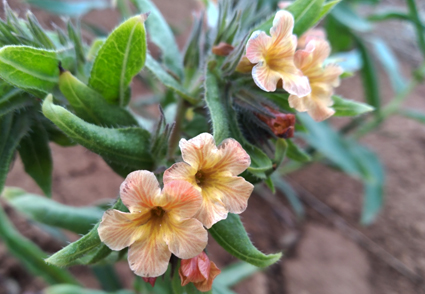Abstract
Alkanna assadii Khajoei Nasab & Zeraatkar (Lithospermeae: Boraginaceae), a new species endemic to hills from Chaharmahal and Bakhtiari province of Iran, is described, illustrated, and compared with similar species. It is mainly compared with A. frigida, from which it is distinguished by its habit, height, basal leaves length and shape, cauline leaves size and shape, setae size, gland size, corolla color, and size, the status of the trichomes and glands in corolla, arrangement of the stamens in the corolla, pedicel length, calyx length, and bract shape and size. Notes on habitat, distribution, ecology, conservation status, and relationships are provided.
References
- Assadi, M. (1989) Plan of the Flora of Iran. Ministry of Agriculture Jihad, Research Institute of Forests and Rangelands. Tehran, 79 pp.
- Chacón, J., Luebert, F., Selvi, F., Cecchi, L. & Weigend, M. (2019) Phylogeny and historical biogeography of Lithospermeae (Boraginaceae): Disentangling the possible causes of Miocene diversifications. Molecular Phylogenetics and Evolution 141: 106626. https://doi.org/10.1016/j.ympev.2019.106626
- IUCN (2022) Guidelines for using the IUCN Red List Categories and Criteria. Version 15. Available from: https://www.iucnredlist.org/resources/redlistguidelines (accessed 20 November 2023)
- Khalvati, S. & Ranjbar, M. (2021) The comparative study of Alkanna and Huynhia (Boraginaceae, Lithospermeae), with description of a new species in Iran. Phytotaxa 524 (4): 216–234. https://doi.org/10.11646/phytotaxa.524.4.1
- Khatamsaz, M. (2002) Boraginaceae. In: Assadi, M., Khatamsaz, M. & Maassoumi, A.A. (Eds.) Flora of Iran, vol. 39. Research Institute of Forests and Rangelands, Tehran, Iran, 420 pp.
- Mozaffarian, V. (2017) Flora of Chaharmahal and Bakhtiari. Chaharmahal and Bakhtiari Agricultural and Natural Resources Research and Education Center. 894 pp.
- Noroozi, M., Ghahremaninejad, F., Bogler, D., Witherspoon, J.M., Ryan, G.R., Miller, J.S., Riahi, M. & Cohen, J.I. (2021) Parsing a plethora of pollen: the role of pollen size and shape in the evolution of Boraginaceae. Cladistics. [23 pp.] https://doi.org/10.1111/cla.12488
- Riedl, H. (1967) Boraginaceae. In: Rechinger, K.H. (Ed.) Flora Iranica 48. Akademische Druck- und Verlagsanstalt, Graz, pp. 1–281.
- Tausch, I.F. (1824) Alkanna Tausch. Flora oder Allgemeine Botanische Zeitung 7 (1): 234–235.
- Thiers, B. (2023) Index Herbariorum: A global directory of public herbaria and associated staff, New York Botanical Garden, New York, U.S.A. Available from: http://sweetgum.nybg.org/science/ih/ (accessed 23 November 2023)
- Yildirim, H. & Şenol, S.G. (2014) Alkanna malatyana (Boraginaceae), a new species from East Anatolia, Turkey. Phytotaxa 164 (2): 124–132. https://doi.org/10.11646/phytotaxa.164.2.6
- Zeraatkar, A. & Mokhtarpour, T. (2023) Mt. Kallar, a home for unique biota in the heart of Zagros: an ideal option for a national park in the alpine regions. Iran Nature 8 (1): 119–131. https://doi.org/10.22092/irn.2023.361265.1497
- Zeraatkar, A., Iranmanesh, Y., Mokhtarpour, T., Shirmardi, H., Jamzad, Z., Jalili, A., Mousavi Vardanjani, S.A. & Soleimani, E. (2023) Kelussia odoratissima Mozaff., a green jewel in Zagros’ rich floral treasure: Conservation status, threats, and opportunities. Iran Nature 8 (4): 123–134. https://doi.org/10.22092/irn.2023.362276.1516


